Christopher alexander - A pattern language
Здесь есть возможность читать онлайн «Christopher alexander - A pattern language» весь текст электронной книги совершенно бесплатно (целиком полную версию без сокращений). В некоторых случаях можно слушать аудио, скачать через торрент в формате fb2 и присутствует краткое содержание. Жанр: Прочая научная литература, на английском языке. Описание произведения, (предисловие) а так же отзывы посетителей доступны на портале библиотеки ЛибКат.
- Название:A pattern language
- Автор:
- Жанр:
- Год:неизвестен
- ISBN:нет данных
- Рейтинг книги:3 / 5. Голосов: 1
-
Избранное:Добавить в избранное
- Отзывы:
-
Ваша оценка:
- 60
- 1
- 2
- 3
- 4
- 5
A pattern language: краткое содержание, описание и аннотация
Предлагаем к чтению аннотацию, описание, краткое содержание или предисловие (зависит от того, что написал сам автор книги «A pattern language»). Если вы не нашли необходимую информацию о книге — напишите в комментариях, мы постараемся отыскать её.
A pattern language — читать онлайн бесплатно полную книгу (весь текст) целиком
Ниже представлен текст книги, разбитый по страницам. Система сохранения места последней прочитанной страницы, позволяет с удобством читать онлайн бесплатно книгу «A pattern language», без необходимости каждый раз заново искать на чём Вы остановились. Поставьте закладку, и сможете в любой момент перейти на страницу, на которой закончили чтение.
Интервал:
Закладка:
| J | i1 | j | i ji |
| *—> | ■ | 1 r | |
| r I rf—1 | Ml | ||
| _^ | ^ j | v. . __ | |
| ’“K I' )l U A way of closing streets to form looped local roads. |
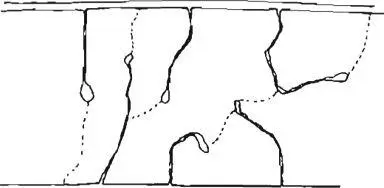 |
| 'Pedestrian paths which go beyond a dead end. |
Dead-end streets are also loops, according to the definition. However, cul-de-sacs are very bad from a social standpoint— they force interaction and they feel claustrophobic, because there is only one entrance. When auto traffic forms a dead end, make sure that the pedestrian path is a through path, leading into the cul-de-sac from one direction, and out of it in another direction.
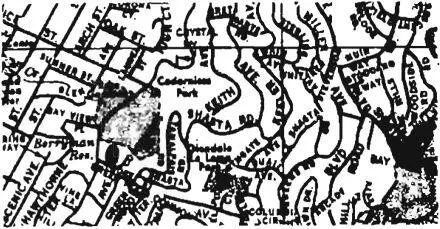 |
| These are not Looped local roads. |
Recognize also that many roads which appear looped are actually not. This map looks as though it has looped roads. Actually, only one or two of these roads are looped in the functional sense defined.
262 49 LOOPED LOCAL ROADS
Therefore:
Lay out local roads so that they form loops. A loop is defined as any stretch of road which makes it impossible for cars that don’t have destinations on it to use it as a shortcut. Do not allow any one loop to serve more than 50 cars, and keep the road really narrow—17 to 20 feet is quite enough.
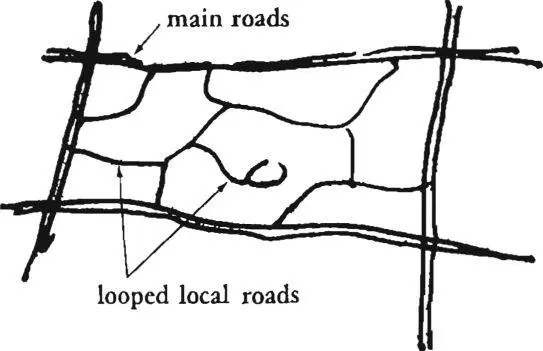
Make all the junctions between local roads three-way T junctions, never four-way intersections—t junctions (50) ; wherever there is any possibility of life from buildings being oriented toward the road, give the road a very rough surface of grass and gravel, with paving stones for wheels of cars—green streets (51); keep parking off the road in driveways—small parking lots (103) and car connection (113) ; except where the roads are very quiet, run pedestrian paths at right angles to them, not along them, and make buildings open off these paths, not off the roads—network of paths and cars (5 2). . . .
263
50 T JUNCTIONS*
. . . if major roads are in position—parallel roads(23), and you are in the process of defining the local roads, this pattern gives the nature of the intersections.It will also greatly influence the layout of the local roads, and will help to generate their looplike character—looped local roads(49).
Traffic accidents are far more frequent where two roads cross than at T junctions.
This follows from the geometry. Where two two-way roads cross, there are 16 major collision points, compared with three for a T junction (John Callendar, Time Saver Standards , Fourth Edition, New York, 1966, p. 1230).
 |
| Sixteen collision points. . . . Three collision points. |
Maps from an empirical study which compares the number of accidents over a period of five years for different street patterns are shown below. They show clearly that T junctions have many fewer accidents than four-way intersections (from Planning for Man and Motor, by Paul Ritter, p. 307).
Further evidence shows that the T junction is safest if it is a right-angled junction. When the angle deviates from the right angle, it is hard for drivers to see round the corner, and accidents increase (Swedish National Board of Urban Planning, “Principles for Urban Planning with Respect to Road Safety,” The Scaft Guidelines iq68 , Publication No. 5, Stockholm, Sweden, p. 11).
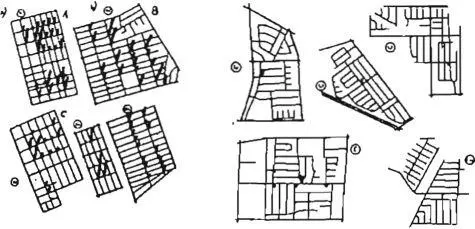 |
| Accidents at different intersections. |
Therefore:
Lay out the road system so that any two roads which meet at grade, meet in three-way T junctions as near 90 degrees as possible. Avoid four-way intersections and crossing movements.
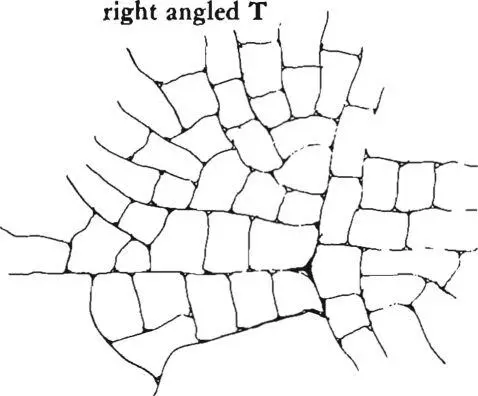
->
At busy junctions, where pedestrian paths converge, make a special raised crossing for pedestrians, something more than the usual crosswalk— road crossing(54). . . .
SUMMARY OF THE LANGUAGE
191 . THE SHAPE OF INDOOR SPACE
192 . WINDOWS OVERLOOKING LIFE
193. HALF-OPEN WALL
194. INTERIOR WINDOWS
195. STAIRCASE VOLUME
196. CORNER DOORS
give all the walls some depth, wherever there are to be alcoves, windows, shelves, closets, or seats;
197. THICK WALLS
198. CLOSETS BETWEEN ROOMS
199. SUNNY COUNTER
200 . OPEN SHELVES
201 . WAIST-HIGH SHELF
202 . BUILT-IN SEATS
203 . CHILD CAVES
204 . SECRET PLACE
At this stage , you have a complete design for an individual building. If you have followed the patterns given , you have a scheme of spaces , either marked on the ground , with stakes , or on a piece of paper , accurate to the nearest foot or so. You know the height of rooms , the rough size and position of windows and doors , and you know roughly how the roofs of the building , and the gardens are laid out.
The next , and last part of the language , tells how to
XXXI
| 51 GREEN STREETS** |
|---|
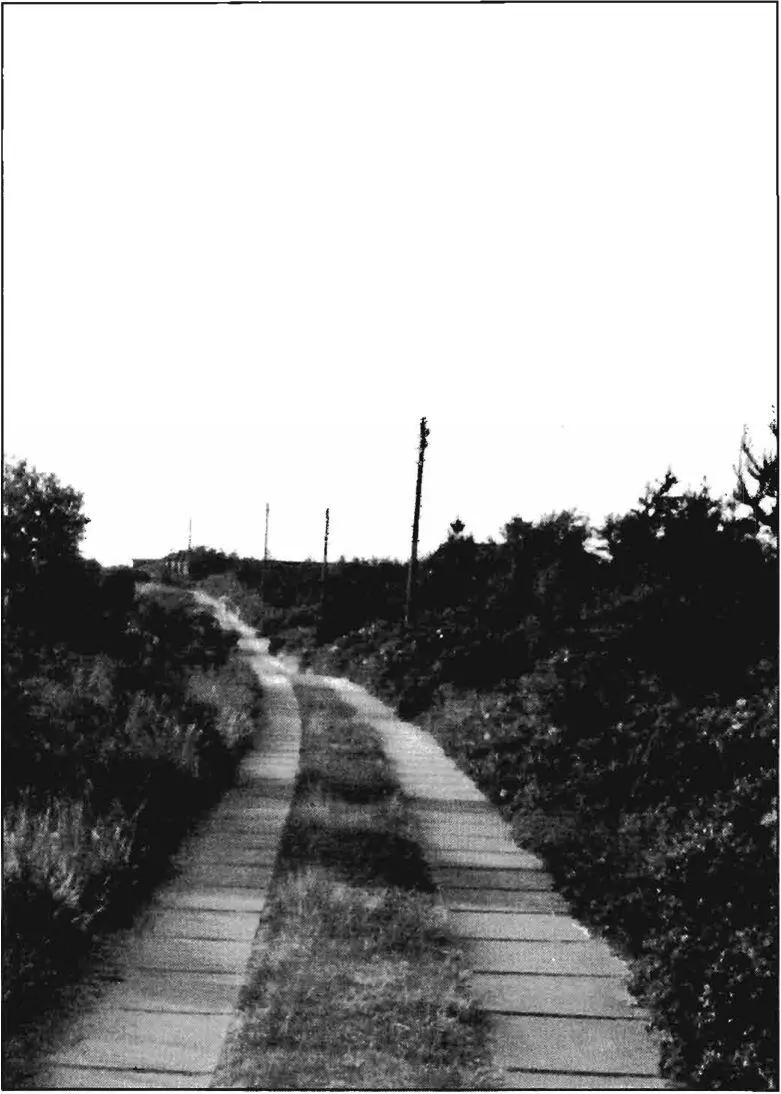 |
266
. . . this pattern helps to give the character of local roads. Even though it only defines the surface of the road, and the position of parking, the gradual emergence of this pattern in an area, can be used, piecemeal, to create looped local roads(49), t junctions(50), and common land(67). This pattern was inspired by a beautiful road in the north of Denmark, built by Anne-Marie Rubin, and illustrated here.
A
There is too much hot hard asphalt in the world. A local road, which only gives access to buildings, needs a few stones for the wheels of the cars; nothing more. Most of it can still be green.
Читать дальшеИнтервал:
Закладка:
Похожие книги на «A pattern language»
Представляем Вашему вниманию похожие книги на «A pattern language» списком для выбора. Мы отобрали схожую по названию и смыслу литературу в надежде предоставить читателям больше вариантов отыскать новые, интересные, ещё непрочитанные произведения.
Обсуждение, отзывы о книге «A pattern language» и просто собственные мнения читателей. Оставьте ваши комментарии, напишите, что Вы думаете о произведении, его смысле или главных героях. Укажите что конкретно понравилось, а что нет, и почему Вы так считаете.












